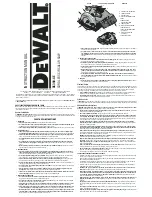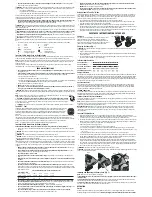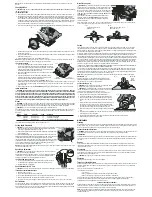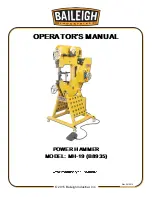
INSTRUCTION MANU
AL
DC390-
XE
CORDLES
S CIR
CUL
AR SA
W
D
E
WALT Industrial Tool Co.,
701 East Joppa Road, Baltimore, MD 21286 • 20 Fletcher Road, Mooroolbark, VIC 3138 Australia
(SEP04) Form No. 625099-00 DC390-XE Copyright © 2004 D
E
WALT
The following are trademarks for one or more D
E
WALT power tools: the yellow and black color scheme; the “D” shaped
air intake grill; the array of pyramids on the handgrip; the kit box configuration; and the array of lozenge-shaped humps
on the surface of the tool.
IF YOU HAVE ANY QUESTIONS OR COMMENTS ABOUT THIS OR ANY D
E
WALT TOOL, CALL US AT:
1800 654 155
(Aust)
or
09 526 2556
(NZ).
SAFETY INSTRUCTIONS FOR POWER TOOLS
When using power tools, always observe the safety regulations applicable in your country to reduce the risk of fire, electric
shock and personal injury. Read the following safety instructions before attempting to operate this product. Keep these
instructions in a safe place.
General Safety Rules
WARNING! Read all instructions.
Failure to follow all instructions listed below may result in electric shock, fire and/or
serious injury. The term “power tool” in all of the warnings listed below refers to your mains operated (corded) power tool
or battery operated (cordless) power tool.
SAVE THESE INSTRUCTIONS
1. WORK AREA
a.
Keep work area clean and well lit.
Cluttered and dark areas invite accidents.
b.
Do not operate power tools in explosive atmospheres, such as in the presence of flammable liquids, gases
or dust.
Power tools create sparks which may ignite the dust or fumes.
c.
Keep children and bystanders away while operating a power tool.
Distractions can cause you to lose control.
2. ELECTRICAL SAFETY
a.
Power tool plugs must match the outlet. Never modify the plug in any way. Do not use any adapter plugs
with earthed (grounded) power tools.
Unmodified plugs and matching outlets will reduce risk of electric shock.
b.
Avoid body contact with earthed or grounded surfaces such as pipes, radiators, ranges and refrigerators.
There is an increased risk of electric shock if your body is earthed or grounded.
c.
Do not expose power tools to rain or wet conditions.
Water entering a power tool will increase the risk of elec-
tric shock.
d.
Do not abuse the cord. Never use the cord for carrying, pulling or unplugging the power tool. Keep cord
away from heat, oil, sharp edges or moving parts.
Damaged or entangled cords increase the risk of electric
shock.
e.
When operating a power tool outdoors, use an extension cord suitable for outdoor use.
Use of a cord suit-
able for outdoor use reduces the risk of electric shock.
3. PERSONAL SAFETY
a.
Stay alert, watch what you are doing and use common sense when operating a power tool. Do not use a
power tool while you are tired or under the influence of drugs, alcohol or medication.
A moment of inatten-
tion while operating power tools may result in serious personal injury.
b.
Use safety equipment. Always wear eye protection.
Safety equipment such as dust mask, non-skid safety
shoes, hard hat, or hearing protection used for appropriate conditions will reduce personal injuries.
c.
Avoid accidental starting. Ensure the switch is in the off position before plugging in.
Carrying power tools
with your finger on the switch or plugging in power tools that have the switch on invites accidents.
d.
Remove any adjusting key or wrench before turning the power tool on.
A wrench or a key left attached to a
rotating part of the power tool may result in personal injury.
e.
Do not overreach. Keep proper footing and balance at all times.
This enables better control of the power tool
in unexpected situations.
f.
Dress properly. Do not wear loose clothing or jewellery. Keep your hair, clothing and gloves away from
moving parts.
Loose clothes, jewellery or long hair can be caught in moving parts.
g.
If devices are provided for the connection of dust extraction and collection facilities, ensure these are con-
nected and properly used.
Use of these devices can reduce dust related hazards.
4. POWER TOOL USE AND CARE
a.
Do not force the power tool. Use the correct power tool for your application.
The correct power tool will do
the job better and safer at the rate for which it was designed.
b.
Do not use the power tool if the switch does not turn it on and off.
Any power tool that cannot be controlled
with the switch is dangerous and must be repaired.
c.
Disconnect the plug from the power source before making any adjustments, changing accessories, or stor-
ing power tools.
Such preventive safety measures reduce the risk of starting the power tool accidentally.
d.
Store idle power tools out of the reach of children and do not allow persons unfamiliar with the power tool
or these instructions to operate the power tool.
Power tools are dangerous in the hands of untrained users.
e.
Maintain power tools. Check for misalignment or binding of moving parts, breakage of parts and any other
condition that may affect the power tools operation. If damaged, have the power tool repaired before use.
Many accidents are caused by poorly maintained power tools.
f.
Keep cutting tools sharp and clean.
Properly maintained cutting tools with sharp cutting edges are less likely to
bind and are easier to control.
g.
Use the power tool, accessories and tool bits etc., in accordance with these instructions and in the man-
ner intended for the particular type of power tool, taking into account the working conditions and the work
to be performed.
Use of the power tool for operations different from those intended could result in a hazardous
situation.
5. BATTERY TOOL USE AND CARE
a.
Ensure the switch is in the off position before inserting battery pack.
Inserting the battery pack into power
tools that have the switch on invites accidents.
b.
Recharge only with the charger specified by the manufacturer.
A charger that is suitable for one type of bat-
tery pack may create a risk of fire when used with another battery pack.
c.
Use power tools only with specifically designated battery packs.
Use of any other battery packs may create a
risk of injury and fire.
d.
When battery pack is not in use, keep it away from other metal objects like paper clips, coins, keys, nails,
screws, or other small metal objects that can make a connection from one terminal to another.
Shorting the
battery terminals together may cause burns or a fire.
e.
Under abusive conditions, liquid may be ejected from the battery; avoid contact. If contact accidentally
occurs, flush with water. If liquid contacts eyes, additionally seek medical help.
Liquid ejected from the battery
may cause irritation or burns.
6. SERVICE
a.
Have your power tool serviced by a qualified repair person using only identical replacement parts.
This will
ensure that the safety of the power tool is maintained.
Electrical Safety
The electric motor has been designed for one voltage only. Always check that the power supply corresponds to the volt-
age on the rating plate. 240 V AC means your saw will operate on alternating current. As little as 10% lower voltage can
cause loss of power and can result in overheating. All D
E
WALT tools are factory tested; if this tool does not operate,
check the power supply. Your D
E
WALT tool is double insulated, therefore no earth wire is required.
•
Young children and the infirm.
This appliance is not intended for use by young children or infirm persons without
supervision. Young children should be supervised to ensure that they do not play with this appliance.
•
Replacement of the supply cord.
If the supply cord is damaged, it must be replaced by the manufacturer or an
authorised D
E
WALT Service Centre in order to avoid a hazard.
Extension Cords
CAUTION:
Use only extension cords that are approved by the country’s Electrical Authority. Before using extension
cords, inspect them for loose or exposed wires, damaged insulation and defective fittings. Replace the cord if necessary.
Additional Safety Instructions
DANGER: Keep hands away from cutting area and blade. Keep your second hand on auxiliary handle or motor
housing.
If both hands are holding the saw, they cannot be cut by the blade.
• Keep your body positioned to either side of the blade, but not in line with the saw blade.
KICKBACK could cause
the saw to jump backwards (see KICKBACK).
• Do not reach underneath the work.
The guard can not protect you from the blade below the work.
• Check lower guard for proper closing before use. Do not operate saw if lower guard does not move freely and
close instantly. Never clamp or tie the lower guard into the open position.
If saw is accidentally dropped, lower
guard may be bent. Raise the lower guard with the Retracting Handle and make sure it moves freely and does not
touch the blade or any other part, in all angles and depths of cut.
• Check the operation and condition of the lower guard spring. If the guard and the spring are not operating
properly, they must be serviced before use.
Lower guard may operate sluggishly due to damaged parts, gummy
deposits, or a buildup of debris.
•
Lower guard should be retracted manually only for special cuts such as “Pocket Cuts” and “Compound Cuts.”
Raise lower guard by Retracting Handle. As soon as blade enters the material, lower guard must be released.
For all other sawing, the lower guard should operate automatically.
•
Always observe that the lower guard is covering the blade before placing saw down on bench or floor.
An
unprotected, coasting blade will cause the saw to walk backwards, cutting whatever is in its path. Be aware of the
time it takes for the blade to stop after switch is released.
• NEVER hold piece being cut in your hands or across your leg.
It is important to support the work properly to
minimize body exposure, blade binding, or loss of control.
•
Hold tool by insulated gripping surfaces when performing an operation where the cutting tool may contact hid-
den wiring.
Contact with a “live” wire will make exposed metal parts of the tool “live” and shock the operator.
• When ripping always use a rip fence or straight edge guide.
This improves the accuracy of cut and reduces the
chance for blade binding.
• Always use blades with correct size and shape (diamond vs. round) arbor holes.
Blades that do not match the
mounting hardware of the saw will run eccentrically, causing loss of control.
• Never use damaged or incorrect blade washers or bolts.
The blade washers and bolt were specially designed for
your saw, for optimum performance and safety of operation.
• Avoid cutting nails. Inspect for and remove all nails from lumber before cutting.
CAUSES AND OPERATOR PREVENTION OF KICKBACK
• Kickback is a sudden reaction to a pinched, bound or misaligned saw blade, causing an uncontrolled saw to lift up
and out of the workpiece toward the operator.
• When the blade is pinched or bound tightly by the kerf closing down, the blade stalls and the motor reaction drives
the unit rapidly back toward the operator.
• If the blade becomes twisted or misaligned in the cut, the teeth at the back edge of the blade can dig into the top
surface of the wood causing the blade to climb out of the kerf and jump back toward operator.
• Kickback is the result of tool misuse and/or incorrect operating procedures or conditions and can be avoided by
taking proper precautions as given below:
•
Maintain a firm grip with both hands on the saw and position your body and arm to allow you to resist kick-
back forces.
Kickback forces can be controlled by the operator, if proper precautions are taken.
• When blade is binding, or when interrupting a cut for any reason, release the trigger and hold the saw motion-
less in the material until the blade comes to a complete stop. Never attempt to remove the saw from the work
or pull the saw backward while the blade is in motion or kickback may occur.
Investigate and take corrective
actions to eliminate the cause of blade binding.
•
When restarting a saw in the workpiece, center the saw blade in the kerf and check that the saw teeth are not
engaged into the material.
If saw blade is binding, it may walk up or kickback from the workpiece as the saw is
restarted.
• Support large panels to minimize the risk of blade pinching and kickback.
Large panels tend to sag under their
own weight. Support must be placed under the panel on both sides, near the line of cut and near the edge of the
panel.
•
Do not use dull or damaged blade.
Unsharpened or improperly set blades produce narrow kerf causing excessive
friction, blade binding, and kickback.
• Blade depth and bevel adjusting locking levers must be tight and secure before making cut.
If blade adjustment
shifts while cutting, it may cause binding and KICKBACK.
A
C
E
B
F
G
K
J
I
H
DC390
18.0 Volt Cordless Circular Saw
3700 RPM
A. SWITCH LOCK-OFF BUTTON
B. TRIGGER SWITCH
C. BATTERY PACK
D. DEPTH ADJUSTMENT KNOB
E. SHOE
F. LOWER GUARD
RETRACTING LEVER
G. LOWER GUARD
H. BLADE CLAMPING SCREW
I. KERF INDICATOR
J. BEVEL ADJUSTMENT KNOB
(not shown)
K. BLADE LOCK BUTTON
(not shown)
L. AUXILARY HANDLE
D
L






















